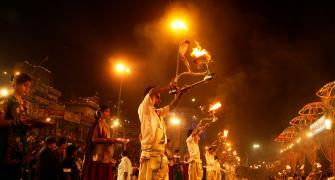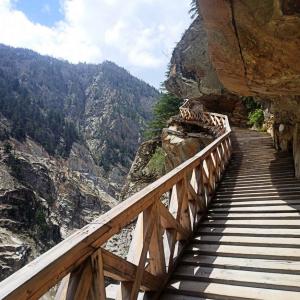'Rather than visiting famous monuments, travellers now prefer "experiential activities" such as biking, trekking/hiking, camping, river rafting, yachting, parasailing and zip lining; safaris and jungle adventures; and wellness holidays to rejuvenate themselves.'

Even as travellers shrugged off the pandemic blues in 2022-2023, the domestic and foreign tourist footfall at India's most popular monuments remained substantially low by comparison to the pre-pandemic peak seen in 2018-2019, according to Archaeological Survey of India data.
The top five monuments, which attracted the highest number of domestic visitors, were the Taj Mahal, the Red Fort, Konark's Sun Temple, the Qutub Minar and Agra Fort. Their footfall was still 11-33 per cent lower in FY23 than in FY19.
The top five monuments for foreign tourists -- the Taj Mahal, the Agra Fort, the Qutub Minar, Humayun's Tomb and Fatehpur Sikri -- saw 50-80 per cent lower footfall in FY23 than in FY19, shows the data reviewed by Business Standard (see charts).
According to travel agents, there are multiple reasons for the persisting gap in numbers pre- and post-Covid.
These include people's preference for remote places for travel after the pandemic, poor maintenance of these sites including a dearth of recreational or add-on activities around them, delayed resumption of international flights in India, and lack of overseas marketing initiatives post-Covid.
"The number of domestic tourists visiting popular monuments is yet to touch pre-pandemic peak as pandemic-induced travel restrictions have led to travellers opting for outdoor and adventure activities," says Rajeev Kale, president and country head, holidays, Thomas Cook (India).
Rather than visiting famous monuments, travellers now prefer "experiential activities" such as biking, trekking/hiking, camping, river rafting, yachting, parasailing and zip lining; safaris and jungle adventures; and wellness holidays to rejuvenate themselves.
Besides, the new and the unknown have taken precedence over the familiar.
Kale observed that travellers are keen to explore India's hidden gems and locales.
"Also, eclectic/unique accommodations like private villas, havelis, tea estates/coffee plantations, treetops, heritage stays, palaces, forts or the heart of a desert or bamboo groves are attracting tourists who want to holiday in the lap of nature," Kale tells Business Standard.
The ASI sites are not as well maintained as they should be, says Rajiv Mehra, president, Indian Association of Tour Operators.
"Confusion prevails over whether entry (to these sites) is with a physical ticket or online booking. These sites also need to be innovative in sustaining people's interest -- if somebody has visited before, they see no reason to return," says Mehra.
"Besides, domestic tourists are exploring new destinations closer to nature that have been unexplored," he adds.
A Mumbai-based travel agent argued that monuments around the world sustain people's interest by introducing recreational activities or adjacent markets.
"Just look at the options -- such as pastry shops and boat rides -- one has around the Eiffel Tower in Paris. Even locals visit with their families. This is not the case with the Taj Mahal," the agent adds.
According to ASI data, the Taj attracted 505,000 domestic visitors in FY23 as compared to 329,000 in the pandemic-hit FY22. However, it had received 566,000 domestic visitors in FY19.
The number of foreign visitors to the country's most popular monument in FY23 was merely 396,900, 50 per cent below the pre-pandemic peak of FY19.
The number of domestic visitors to the Qutub Minar was 176,000 in FY23 and 115,000 in FY22. The FY19 numbers were as high as 261,000.
Foreign arrivals to the Delhi monument, on the other hand, were 62 per cent lower than FY19.
The agent adds that government promotion of these sites in foreign countries began very late in FY23, which also affected inbound tourism.
Besides, India removed pandemic-induced restrictions and allowed scheduled international flights in March 2022.
"This is also why the number of foreign arrivals was fewer, especially during the early part of FY23," the agent says.
Karthick Prabu, head of strategy, Cleartrip, says India's domestic air travel still hasn't recovered to pre-pandemic levels on a full-year basis although the country has surpassed the pre-pandemic passenger numbers on a daily basis.
"In the rail sector, as of February 2023, the total train passengers are still 24 per cent less than pre-pandemic figures. The situation is more or less similar in the bus industry.
"With a strong recovery in the past 12-18 months, the visits to historical monuments are averaging 80 per cent of pre-pandemic figures," he explains.
Cleartrip is confident that in FY24, domestic visitors to these monuments will surpass the pre-pandemic high because of the "expected full-year recovery in all modes of transport", Prabu adds.
"Though we have witnessed a significant boost and uptick in travel, the Indian tourism industry is still in revival mode," says Nishant Pitti, CEO and co-founder, EaseMyTrip.
Compared to 2022, Pitti says there was a 166 per cent increase in the number of foreign tourist arrivals in January-April of 2023.
"This is a significant hike and we anticipate this number to keep increasing," he adds.
"One of the major contributing factors is the G20 meetings held in India as well as the prolonged positive travel sentiment among travellers."

Feature Presentation: Ashish Narsale/Rediff.com










